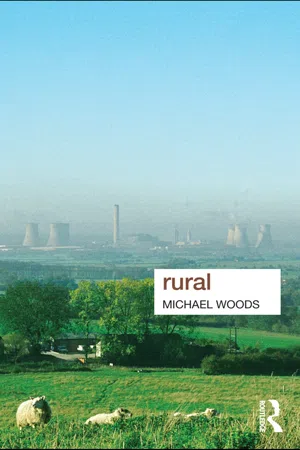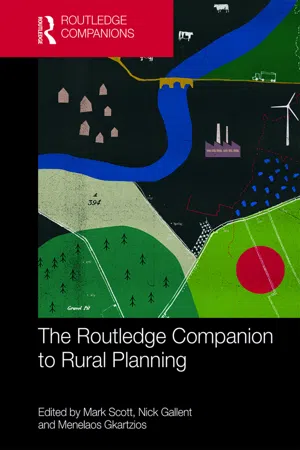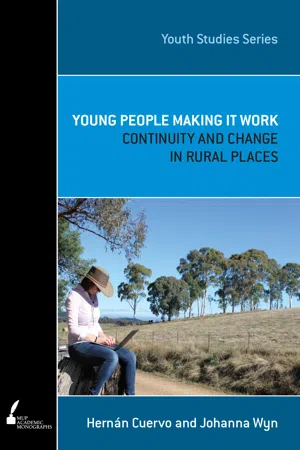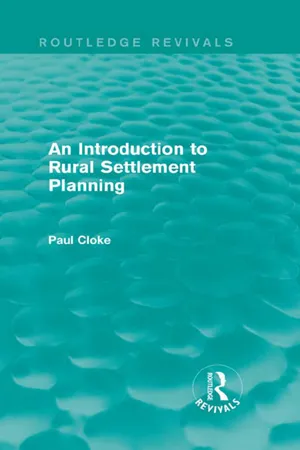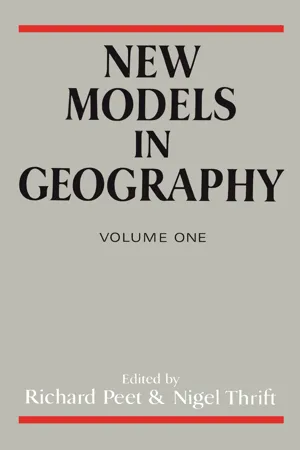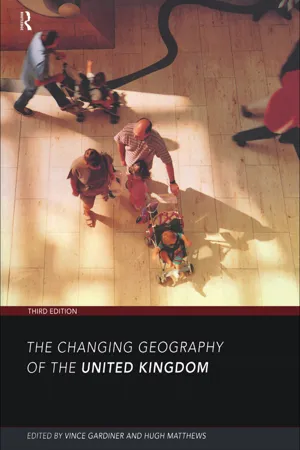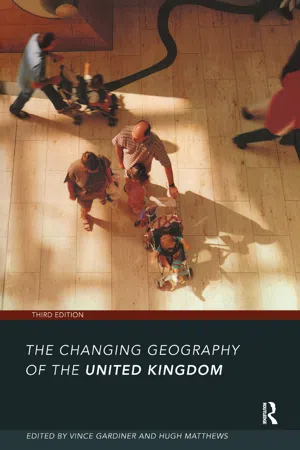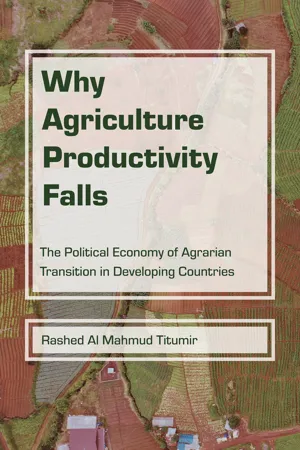Geography
Rural Change
Rural change refers to the transformation and evolution of rural areas over time. This can include shifts in population, economic activities, land use, and infrastructure. Factors driving rural change may include technological advancements, agricultural practices, urbanization, and government policies. Understanding rural change is important for analyzing the dynamics of rural communities and their interactions with the broader society.
Written by Perlego with AI-assistance
Related key terms
Related key terms
1 of 4
Related key terms
1 of 3
10 Key excerpts on "Rural Change"
- eBook - ePub
- Brian W. Ilbery(Author)
- 2014(Publication Date)
- Routledge(Publisher)
CHAPTER 1 DIMENSIONS OF Rural Change Brian IlberyINTRODUCTORY SETTING
Rural Change is multidimensional and the countryside in developed market economies can no longer be viewed as being on the margins of economic, social and political change. Indeed, rural areas are now at the centre of interest and debate (Rogers, 1993) and many of the processes of change stem from broader and more general socio-economic and political processes. As a consequence, policy makers are having to re-evaluate policies relating to ‘rural space’. The countryside is increasingly an area of consumption as well as production and the switch away from a productivist philosophy means that farmers and other primary producers are looking for new ways of generating income. Alternative uses of rural space are developing, and as Cloke and Milbourne (1992, p. 360) comment, ‘there is no longer one single rural space, but rather a multiplicity of social spaces that overlap the same geographical area’.This book is concerned with detailing and understanding the often complex processes and outcomes of change which have recently been experienced by rural areas in developed market economies. It emphasizes the spatial manifestations of Rural Change and provides up-to-date insights into different dimensions of rural restructuring, written by experts in their respective fields. Different theories, concepts and principles are outlined where relevant, but the book deliberately avoids adopting any one particular and overriding theoretical framework. Indeed, with the exception of the two theoretical chapters (Chapters 2 and 3 ), authors have been encouraged to develop their chapters in whatever they consider to be the most appropriate manner. Students need to be aware of this diversity of approach, which reflects the nature of debate in rural geography. The result is a book in which some chapters provide essentially empirical reviews of particular dimensions of Rural Change, whereas others develop a stronger theoretical component. In keeping with the general tenor of this diversity of approach, the book does not adopt any standard definition of either rural or rurality - This final chapter looks forward to rural futures. It does so by focusing on three arenas in which the rural is being re-made as a multi-authored, multi-faceted and co-constituted space, and which are starting to attract the attention of geographical research. First, it examines the transformation of the rural under contemporary globalization, and in particular the reconfiguration of rural places through the hybrid engagements of local and global actors. Second, it considers the role of nonhuman agency in disrupting and re-shaping the rural, and the significance of this for rural adjustment to climate change. Finally, it documents the re-assertion of rural identity by new rural social movements in both the global north and the global south, and their contribution to the contestation of the meaning and regulation of rural space in a ‘politics of the rural’.
THE GLOBAL COUNTRYSIDE?
Globalization and the rural
A recurrent theme throughout this book has been the significance of globalization as a driver of Rural Change, or perhaps, more correctly, the significance of diverse globalization processes as drivers of Rural Change. The variety of contexts in which globalization has been encountered – trade and economic production, tourism, migration, media representations and environmental regulations – points to the multiple character of globalization, corresponding with Steger’s (2003) definition of globalization as ‘a multidimensional set of social processes that create, multiply, stretch, and intensify worldwide social [and economic] interdependencies and exchanges while at the same time fostering in people a growing awareness of deepening connections between the local and the distant’ (p. 13) (see Box 9.1 ).Box 9.1 GLOBALIZATIONGlobalization is a widespread but loosely used term that can refer to a condition, or a process, or a discourse. Steger’s definition, quoted in the main text, identifies globalization as a set of processes, but is useful in the way that it draws out some of the key characteristics of these processes. First, Steger (2003) proposes that globalization ‘involves the creation of new, and the multiplication of existing, social networks and activities that increasingly overcome traditional political, economic, cultural, and geographical boundaries’ (p. 9). Second, globalization involves the expansion and stretching of social and economic relations, activities and interdependencies over increasing distances. Third, globalization involves the intensification and acceleration - eBook - ePub
- Mark Scott, Nick Gallent, Menelaos Gkartzios, Mark Scott, Nick Gallent, Menelaos Gkartzios(Authors)
- 2019(Publication Date)
- Routledge(Publisher)
Part IV Social change and planningPart IV deals with planning issues in the context of a continuously changing rural society. Social change and rural restructuring and social change have been discussed from the 1970s, with new social agents, sometimes the middle classes, rediscovering the countryside and bringing new meanings and expectations about what it is to be rural. These changes have had profound effects in rural communities and have created new contested arenas of planning policy and conflict in terms of infrastructure and services. The aim of this section is to discuss these planning issues in the context of continuous social change.The part starts with a chapter by Smith, Phillips, Kinton and Culora on emerging rural geographies. The authors briefly discuss the influential concept of the ‘differentiated countryside’ in order to introduce their study of population dynamics in the cases of England and Wales in the UK. Georeferenced data from the censuses of 2001 and 2011 are analysed and mapped to produce a nuanced understanding of uneven contemporary rural geographies. The hypothesis of an increasingly differentiated countryside is confirmed through particular explorations regarding the distribution of rural populations (by employment, class, age and family formation types) and what this might mean for services and planning policy. Key processes highlighted in the chapter are counterurban-led rural gentrification as wells as the restructuring of agriculture and, wider, rural economies.The following chapter presents undoubtedly the most debated issue as a result of shifting preferences for rural residential environments and associated social change in the countryside, housing. This is discussed by Gallent and Scott who, in the second chapter of this section, provide an overview of the demand and supply factors resulting in well observed housing inequalities. Rural housing research is complicated because the policy challenges faced by the planning systems are very different internationally. This is evidenced for example through the insightful comparison provided here between imposing occupancy conditions in a case study in England (a context characterised by limited housing provision in rural areas, housing market distortions and issues of exclusion) and the case of ‘locals only’ planning restrictions in the Republic of Ireland (a context characterised by a period of housing oversupply and a pro-development rural planning ethos). Both cases demonstrate the multiple ways that new consumer preferences and social change in rural areas, have resulted in spatially selective inequalities. - eBook - ePub
Young People Making It Work
Continuity and Change in Rural Places
- Hernán Cuervo, Johanna Wyn(Authors)
- 2012(Publication Date)
- MUP Academic Digital(Publisher)
1 Changing rural landscapesYoung people live within the dynamics of their communities. Understanding the restructuring of rural spaces—the economic, social, political and cultural transformations that have occurred since the 1980s—and the relationship between the local and the global is critical to comprehending their experiences. Identifying the significant social changes in rural settings enables us to understand how young people make sense of the place where they live, how they negotiate the different spheres of their lives (for example, study, work and their social life), and what are the opportunities and challenges to construct a life.Bureaucratic, statistical and dichotomous constructions of rurality tell us very little of the challenges and opportunities for young people living in rural settings. They also fail to explain important social, economic and political changes transforming rural spaces. We argue that an interdisciplinary approach enables us to gain a perspective on the significant changes in rural settings and to understand how they shape the experiences of young people. In this chapter we focus on structural changes that have affected rural spaces in the last decades. These changes have added to the complexity and heterogeneity of rural areas.Our analysis emphasises the shifting states of social and economic relations and the new patterns emerging in rural spaces. We base our analysis on two broad social landscapes, ‘production’ and ‘amenity’, to highlight the different forces that shape the opportunities and challenges confronted by young people in rural areas.First we provide a succinct but poignant depiction of the impact of neoliberal policies in the reconfiguration of rural spaces. Following the contextual analysis of rural landscapes we theorise the influence of these structural changes on the lives of young people. Next we analyse the educational and work patterns of youth transitions in relation to the processes and outcomes of rural restructuring. Finally, we pay particular attention to the shifts in rural communities and their influence on generational relations and processes of counter-urbanisation that affect the meaning of what is to be rural. - eBook - ePub
- Birgit Jentsch, Mark Shucksmith(Authors)
- 2017(Publication Date)
- Routledge(Publisher)
These may be summarised as cultural, social, human and natural capital. Their role in rural development is discussed further in Shucksmith (2000).Demographic and Social Changes
Fundamental demographic, social and cultural changes also characterise rural areas. Migration flows are critical in determining rural population levels and, while some rural areas in Europe continue to lose population, in many parts people are moving into rural areas because of the new values placed on rural space (e.g. clean environment, healthy lifestyles, community life). The consequences of the imposition of such values on rural societies may be far reaching. Between 1971–1996, for example, the population of rural England grew by 24%, compared to 6% nationally. Across the EU, 46% of predominantly rural regions are growing, while 42% experience population decline; and of significantly rural regions 57% are growing, while only 34% decline (EC 1997, 10).1This migration tends to be highly socially selective. Gentrification has been evident in many accessible or touristic areas of rural Europe, in so far as the affluent middle classes have migrated into the countryside, perhaps displacing less affluent groups (cf. Phillips 1993 for evidence of this process in Britain) through competition for scarce housing. Much has been written about the rise of a rural professional and managerial ‘service class’ such that certain regions, notably the Southeast of England, may be colonised by knowledge-workers at a distance from production activities. Even in some attractive remoter areas, retirement migration and distance-working may produce similar effects, though in less attractive (or ex-industrial) rural areas, with low wages and low rents, low-grade jobs may be all that can be attracted. The migration also tends to be age-specific, with young people often leaving rural areas, as discussed later in this chapter, and older families moving in. - Paul Cloke(Author)
- 2013(Publication Date)
- Routledge(Publisher)
The changes taking place in rural areas are complex and interconnected. Although a repopulation appears to be taking place in many areas, it is clear that problems generic to small remote settlements continue to be important and to require planning action. Given these rather complicated spatial manifestations of change, our understanding of rural trends is perhaps best enhanced by a view of the systematic forces which are sponsoring change in rural settlements.Agents of changeNo clear-cut and distinctive boundaries exist between the various forces which have prompted changes in rural settlements and communities. Change has come from a series of interrelated factors imposed on a sparsely populated settlement structure. This has created an impetus for change which is greater than the combined influence of the individual components. Nevertheless five broad agents of change may be isolated which contribute to the overall processes of dynamism in rural settlements, and to these is added the factor of inertia which has perhaps prevented positive changes and indirectly promoted somewhat more harmful trends.Decline in traditional labour forces
A fundamental instigating process in Rural Change has been the wholesale decline in traditional forms of rural employment. This trend has been well documented (Ministry of Agriculture, Fisheries and Food, 1967; Chisholm and Oeppen, 1973) and is so established a phenomenon that Kotter (1962) was able to describe it as an inevitable process in the development of a civilized economy. In 1750, 75 per cent of Britain's population was employed on the land. By 1801, census material reveals that this proportion had decreased to less than 50 per cent and by 1951 a mere 20 per cent of the population was employed in agriculture. Today the figure has fallen to around 2 per cent although another 8 per cent are employed in ancillary and support trades mainly based in urban locations. Farming, however, has never been the only source of employment for the rural labour force. The primary employment in farming, forestry and quarrying was traditionally balanced by a profusion of secondary small craft and consumer industries, and in fact it was this industrial element of the rural economy which was first to suffer from technical development (in this case the development of urban-based industry in the Midlands and the North). Bonham-Carter (1976, 28) paints a vivid image of rural craft industry ‘flickering out like the flame of a dying candle all through the nineteenth century’.- eBook - ePub
- Richard Peet, Nigel Thrift(Authors)
- 2013(Publication Date)
- Routledge(Publisher)
Countryside Planning Yearbook ). Such institutional momentum is difficult to decelerate, even if important theoretical advances are to be spurned because they do not fit the pattern of rural separatism.There has, therefore, developed a culture of rurality. Rural space has been defined and preserved in the archives and annals of rural studies as being that area which(a) is dominated (either currently or recently) by extensive land uses, notably agriculture and forestry; (b) contains small, lower order settlements which demonstrate a strong relationship between buildings and extensive landscape, and which are thought of as rural by most of their residents;(c) engenders a way of life which is characterized by a cohesive identity based on respect for the environmental and behavioural qualities of living as part of an extensive landscape (Cloke & Park 1985).Points (a) and (b) have remained relatively unshaken in the minds of rural geographers but point (c) has been under attack for more than a decade from those (see, for example, Bailey 1975, Cloke & Griffiths 1980) who have argued that the defining parameters of social problems (such as poverty, powerlessness, and so on) should be represented by common variables of social production, thus rendering the rural-urban difference defunct.The conflict between land use/settlement characteristics and socio-economic characteristics within the culture of rurality has steadily widened, and indeed the progressive debate over socio-spatial relations amongst prominent political-economic theorists has removed the theoretical debate far beyond the mere recognition of the fact that Britain and many other Western countries are by now culturally if not physically urbanized. The degree to which spatial considerations have been prioritized in political-economic theory has ebbed and flowed over recent years. Using Dunleavy’s (1980) Urban political analysis - eBook - ePub
- Hugh Matthews, Vince Gardiner(Authors)
- 2002(Publication Date)
- Routledge(Publisher)
Chapter 11Rural Change and development
Malcolm Moseley
Introduction
The first problem with rural Britain is to define it. Indeed, the first task is to question its existence altogether! That statement is not an excuse for bemoaning the so-called fact that our leafy shires are rapidly disappearing under a tidal wave of concrete—a much exaggerated bit of scaremongering—but merely a recognition that although nine-tenths of our island is still visually ‘countryside’, in social and economic terms the distinctiveness of ‘rural Britain’ is fast disappearing. Our island is shrinking, as much because of advances in telecommunications as because of those in transport availability, and the argument that most of midland and southern England is now one vast dispersed metropolis, whatever the view from the window, is now a compelling one.But ‘rural areas’ —however defined—do have certain characteristics, notably low population density and a much sought after green environment, which give national social and economic trends and problems a peculiar twist when they surface in that milieu. It is those ‘twists’ to which this chapter will be devoted. Look in other chapters if your interest is predominantly in that minority but necessarily rural industry called agriculture (Chapter 5 ), in land use per se (Chapter 20 ), or in the physical environment of the countryside (Chapters 17 and 20 ).As for a definition, the criteria most commonly used are population density, the proportion of built-upon land, remoteness from urban centres, and degree of reliance upon ‘land extensive’ economic activities (notably agriculture, horticulture, forestry, quarrying, fishing, environmental management, green tourism and outdoor recreation). But every researcher applies such criteria in a different way (how remote is ‘remote’?; what density is ‘low density’?) and data availability imposes its own complications. In short, there is no unambiguous domain called ‘rural Britain’. - eBook - ePub
- Hugh Matthews, Vince Gardiner(Authors)
- 2020(Publication Date)
- Routledge(Publisher)
Chapter 11Rural Change and development
Malcolm Moseley
Introduction
The first problem with rural Britain is to define it. Indeed, the first task is to question its existence altogether! That statement is not an excuse for bemoaning the so-called fact that our leafy shires are rapidly disappearing under a tidal wave of concrete – a much exaggerated bit of scaremongering – but merely a recognition that although nine-tenths of our island is still visually ‘countryside’, in social and economic terms the distinctiveness of ‘rural Britain’ is fast disappearing. Our island is shrinking, as much because of advances in telecommunications as because of those in transport availability, and the argument that most of midland and southern England is now one vast dispersed metropolis, whatever the view from the window, is now a compelling one.But ‘rural areas’ – however defined – do have certain characteristics, notably low population density and a much sought after green environment, which give national social and economic trends and problems a peculiar twist when they surface in that milieu. It is those ‘twists’ to which this chapter will be devoted. Look in other chapters if your interest is predominantly in that minority but necessarily rural industry called agriculture (Chapter 5 ), in land use per se (Chapter 20 ), or in the physical environment of the countryside (Chapters 17 and 20 ).As for a definition, the criteria most commonly used are population density, the proportion of built-upon land, remoteness from urban centres, and degree of reliance upon ‘land extensive’ economic activities (notably agriculture, horticulture, forestry, quarrying, fishing, environmental management, green tourism and outdoor recreation). But every researcher applies such criteria in a different way (how remote is ‘remote’?; what density is ‘low density’?) and data availability imposes its own complications. In short, there is no unambiguous domain called ‘rural Britain’. - eBook - ePub
Why Agriculture Productivity Falls
The Political Economy of Agrarian Transition in Developing Countries
- Rashed Al Mahmud Titumir(Author)
- 2023(Publication Date)
- Purdue University Press(Publisher)
Agricultural practices in Iran are vulnerable to climate change impacts in the form of changes in precipitation, temperature, and carbon dioxide fertilization. In the absence of effective adaptation measures, these may bear significant adverse impacts on crop yield, irrigation requirements, and the income of farming communities. The government’s current efforts center around advancing technology and changes in the institutional environment, coupled by farmer responses of diversification of livelihood strategies, crop variations, and increased investment in irrigation infrastructure and water-saving technologies (Karimi et al., 2017). Climate change also plays a significant role in determining the pathway of agrarian transition in a country through its impacts on agricultural productivity and adaptive responses. Therefore, this chapter selected stories from representative farming communities from a developing country that comprises all the forces — population pressure, urbanization, and climate change — that mold the pathway of agrarian transition.Internal migration in China is made up of “rural migrant labor,” which refers to a specific group of industry and service sector workers with the rural hukou or the household registration system. These migrant laborers, despite their employment in urban areas, are regarded as “rural” and therefore deprived of urban welfare benefits. As a result, the rural migrant workers rely on subsistence wages that give them a very minimal living, and they are regarded as the “new and true urban poor.” In 2008, the global financial crisis led to a mass exodus of these rural migrant workers to their villages, as global demand for Chinese exports plummeted, leaving a large population of subsistence wage earners in precarity (Chan, 2010).The chapter sets the scene on the dynamics of contemporary agrarian transition, based upon the data collected from field surveys of four villages in a developing country, selected on the grounds of having a relatively large population in proportion to land area available, which is the case in Bangladesh. The village-wise sections identify broader trends to depict the nature of accumulation. Each section starts by looking at the demographic dynamics, goes on to show the trends in land relations in these villages, and makes comparisons between the data of the national average vis-à-vis the census done for the study. Two subsections are devoted to capturing the accumulation process through analyzing the census data on production, exchange, and technological processes. The final part of these village-wise sections explores the collected data in relation to land transactions, decisions regarding transactions, and consequential associations with power, politics, and the state. The chapter therefore serves as the ethnographic and qualitative side to the triangulation method discussed earlier.
Index pages curate the most relevant extracts from our library of academic textbooks. They’ve been created using an in-house natural language model (NLM), each adding context and meaning to key research topics.
Explore more topic indexes
Explore more topic indexes
1 of 6
Explore more topic indexes
1 of 4

